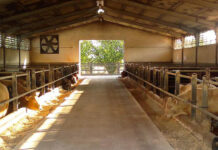Cameras in slaughterhouses, the British example. The Conservative Downing Street government fulfills its election promises and introduces by law, as of 4.5.18, a requirement to install Closed Circuit Television(CCTV) systems in all areas where live animals are present. Some reflections to follow.
Cameras in slaughterhouses, the British example
In England-as in many other countries, in the EU and around the world-serious scandals have emerged in recent years regarding cruelty to animals in some slaughter plants.
European legislation is cutting edge, on the safety front as well as on the animal welfare front, (1) but its violations by individual criminal organizations have undermined the general public’s confidence in the industry.
The British party now in government had already promised to take appropriate measures to ensure transparency and animal welfare. And it actually fulfilled the commitments, following consultation with the Secretary of State for Environment, Food and Rural Affairs in August 2017.
All the slaughterhouses in the country must install an appropriate CCTV system within the next six months (5.11.18), allowing unrestricted access to all footage by public official vets. Who will thus be able to verify actual compliance with welfare standards, even in cases of ritual slaughter.
‘We are a nation that cares about animals, and these strict measures will ensure that all animals are treated with the utmost respect at all stages of life, allowing us to continue to lead the way in raising welfare standards’
(Lord John Gardiner, Secretary of State for Rural Affairs and Biosecurity, with responsibility for, among other things, animal health and welfare).
Operation transparency in England, on closer inspection, also stems from citizen pressure toward institutions. Following public inquiries that showed violations of essential health standards by 29 percent of slaughterhouses inspected, as well as revealing drastic reductions in the number of public veterinary inspections. Disturbing data which, not surprisingly, have been accompanied by those of growing foodborne illnesses. (2)
Cameras in slaughterhouses, when in Italy?
The question to be asked is whether the British example of cameras in slaughterhouses can be followed in Italy as well. If favorable, under what conditions and perspectives. Our legal system is more complex than the British system, including in terms of workers’ rights. And yet, the solution under consideration seems to be the most suitable to systematically prevent and control any animal abuse. Also with a view to improving food safety standards.
We discuss this with Fabrizio De Stefani, one of the most lucid experts in the field. (3) ‘The possibility of Italian slaughterhouses making CCTV footage – to be installed in areas of slaughterhouses where live animals are present (stalling, restraining, stunning, slaughtering and killing points) – available to public veterinary services is to date remote’, Dr. De Stefani explains. ‘Such a hypothesis, in our country, is in fact conditional on the maturation of a consensus that must involve the workforce.’
‘
This
innovation
‘ – Fabrizio De Stefani continues. can be an important opportunity, however, to ensure compliance with the requirements placed on operators. With the twin goals of ensuring the reduction of animal suffering and optimizing official public veterinary controls in slaughterhouses. In particular, in establishments where it is not possible to ensure the continuous presence of veterinary inspectors at so-called ‘death points.’
‘
It must therefore be hoped
that the challenge ‘Cameras in Slaughterhouses’ be welcomed by Italian meat enterprises in agreement with their employees and collaborators. To give proof, even to the most hostile detractors, that there is no intention to hide anything about the procedures designed to minimize as much as possible the albeit inevitable pain that accompanies the transformation of a life into food.’
In the era of rampant ‘institutional distrust’
, the possibility of offering foods with high ethical content – and accepted as such by consumers because they are obtained from animals whose compassionate sacrifice is documented by video recordings verifiable by the relevant authorities – can enable businesses to regain consumer confidence. Those who are no longer willing to be satisfied with the statements of operators alone, which are often branded as self-referential. There are thus obvious benefits to the reputation of virtuous enterprises.’
Cameras in slaughterhouses thus represent an initiative that the nascent Italian government might consider carefully.
Dario Dongo
Notes
(1) Suffice it to mention in this regard that the new definition of ‘hazard’ referring to food, introduced by Reg. EU 2017/625, also includes failure to comply with animal welfare (as well as health) conditions. See the article https://www.greatitalianfoodtrade.it/salute/sicurezza-alimentare-abc-responsabilità-operatori
(2) See
https://www.thebureauinvestigates.com/stories/2017-09-19/blowing-the-whistle-on-the-meat-industry
(3) Fabrizio De Stefani is acting director of the Veterinary Food Hygiene Service of the Veneto ASL 7. He has written several articles on this topic as well, including.
– Cameras in Italian slaughterhouses? The law, for now, does not allow it
– Cameras in slaughterhouses closer?
Dario Dongo, lawyer and journalist, PhD in international food law, founder of WIISE (FARE - GIFT - Food Times) and Égalité.








